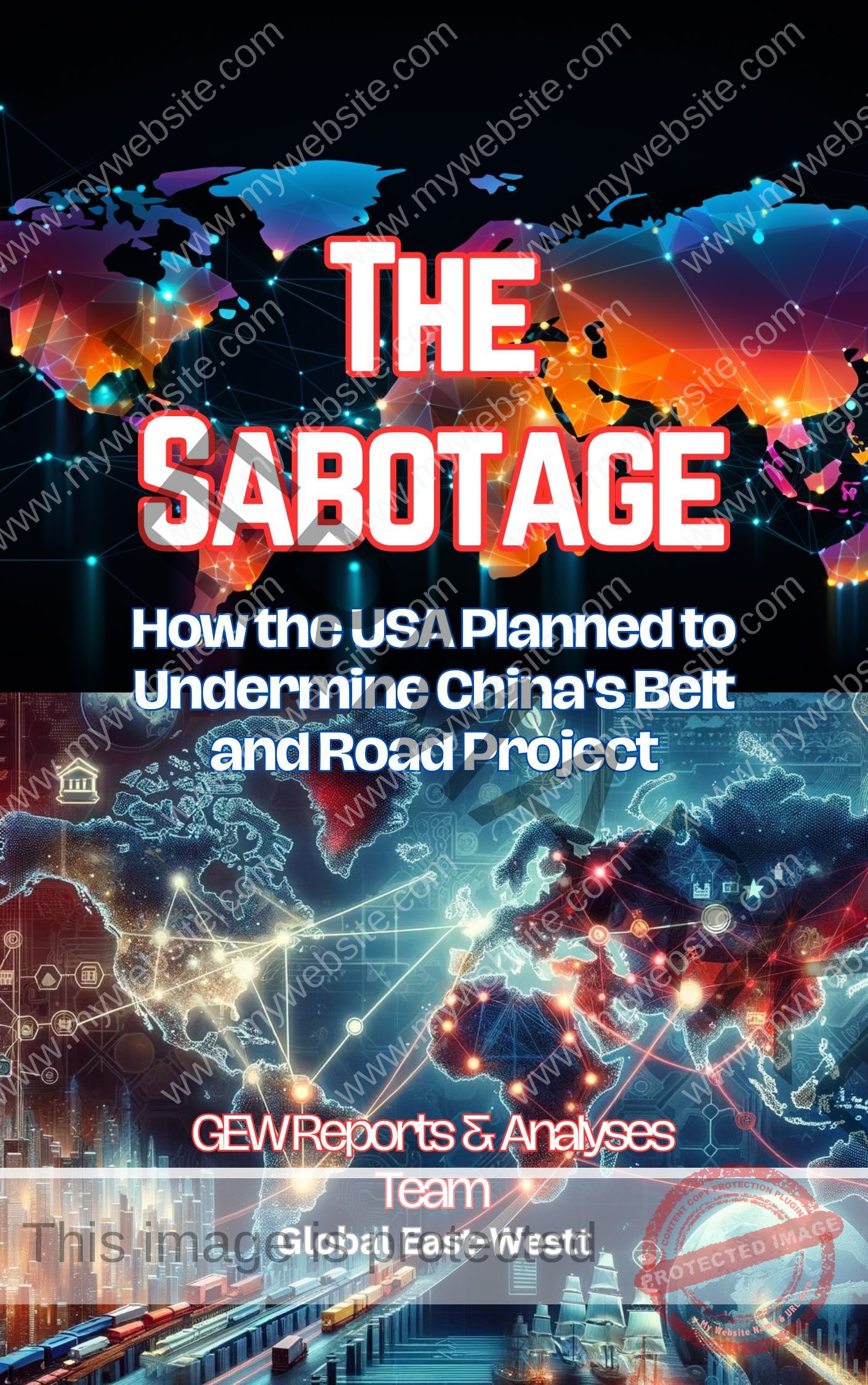GEW Essays & Reports
By GEW Reports and Analyses Team
Summary
“The Sabotage” is a comprehensive examination of the geopolitical competition between China and the United States, focusing on the strategic initiatives and manoeuvres adopted by these powers to assert their influence globally.
Introduction: The book opens by outlining the intensifying global competition, with China’s Belt and Road Initiative (BRI) as a focal point. This monumental project, envisioned by Chinese President Xi Jinping, aims to enhance connectivity, trade, and infrastructure development across vast regions. The United States, perceiving China’s growing influence as a threat to its supremacy, has adopted multifaceted strategies to counter the BRI, including the development of the India-Middle East-Europe Economic Corridor (IMEEC) as an alternative trade route.
The Rise of China’s Belt and Road Initiative: This chapter delves into the origins, objectives, and implications of the BRI. The initiative aims to re-establish economic links along the historic Silk Road and expand connectivity and partnerships across new regions. It represents China’s ambition to reshape global trade and governance, but it has also sparked concerns among Western powers, particularly the United States.
The USA’s Countermove – The India-Middle East-Europe Corridor: In response to the BRI, the United States focuses on developing the IMEEC. This initiative is crucial for the USA to reclaim its global position and counterbalance China’s dominance. The IMEEC hinges on strategic partnerships with India, the Middle East, and Europe. The USA’s strategy includes strengthening partnerships, infrastructure development, digital connectivity, and regional security and stability initiatives. These efforts are aimed at promoting connectivity, trade, and economic ties among participating nations while ensuring regional security.
In conclusion, “The Sabotage” presents a detailed analysis of the dynamic and complex geopolitical struggle between China and the United States. It highlights these global powers’ strategic moves and counter-moves as they vie for influence, shaping the emerging world order. The book underscores the significance of the BRI and IMEEC in this global power play and their broader ramifications on regional and international politics.
Practical Implications of the book:
– The book highlights the potential implications of the transnational rail and port agreement on global geopolitics, emphasizing the need for China and its allies to react to avoid shaping the future of global geopolitics.
– It discusses the formation and challenges faced by the BRICS (Brazil, Russia, India, China, and South Africa) in challenging the Western-dominated global order and advocating for reforms that better reflect the interests of emerging economies.
– The book also mentions the potential for disruptive socioeconomic changes and questions of national sovereignty about transnational infrastructure, emphasizing the importance of stakeholder engagement and comprehensive impact assessments.
– Furthermore, it highlights the implications of the United States’ strategic bet on India and its attempts to weaken the BRICS, potentially leading to a shift in alliances and the formation of new power blocs, with implications for global governance, trade patterns, and regional security dynamics.
Overall, the book provides insights into the potential implications of the transnational rail and port agreement, the challenges faced by the BRICS, the importance of stakeholder engagement, and the potential shifts in global alliances and governance.
Introduction to “The Sabotage”
The quest for dominance and influence has emerged as a defining characteristic of our modern world in an era of constantly intensifying competition on a global scale. At the core of this intricate and multifaceted rivalry lies the audacious Belt and Road Initiative (BRI), championed by China—a monumental shift in global economics and geopolitics. “The Sabotage” delves profoundly into the intricacies of this worldwide power struggle, unveiling the meticulously orchestrated strategic responses enacted by the United States to counter and challenge the continually expanding reach of China’s BRI.
The BRI, conceived by Chinese President Xi Jinping, envisions bolstering connectivity, trade, and infrastructure development across vast expanses of Asia, Europe, Africa, and beyond, fostering economic integration and regional cooperation. However, this audacious endeavour has not merely reshaped the global trade and governance framework. It has also ignited substantial resentment among Western powers, most notably the United States. Perceiving the burgeoning influence of China as a potential threat to its global supremacy, the United States has adopted a multifaceted approach in a last effort to stop, contain, or hinder the ambitions of the BRI.
The present work presents a first analysis of the United States’ strategic manoeuvres, focusing on creating the India-Middle East-Europe Corridor (IMEEC)—an alternative trade route designed to circumvent China’s dominance. By cultivating strategic alliances with key nations in the Middle East and Europe, the United States endeavours to re-establish its shaky position in the global hierarchy and present a counterbalance to China’s ascending and, according to many international observers, unstoppable pre-eminence.
“The Sabotage” not only delves into the geopolitical duel between these two – ascending Vs descending – global powers, but also scrutinises the broader ramifications of these actions on regional and international politics. From deploying intricate diplomatic and economic strategies to fortifying alliances and providing unwavering security assurances, the United States employs a gamut of tactics to adeptly navigate the intricate dynamics of the region and address pressing local concerns. The strategic recontrol and realignment of pivotal nations such as Saudi Arabia and the United Arab Emirates, becoming too much independent in the American eyes, further underscores the ever-evolving geopolitical landscape.
As we delve into the intricacies of this global power struggle, “The Sabotage” unfurls a riveting narrative that underscores the desperate attempt of the United States, as it is losing speed, to uphold a delicate balance of power and safeguard its strategic interests in the face of China’s ever-expanding influence. Through collaborative partnerships, ambitious infrastructure development initiatives, and a delusory commitment to regional security and stability, the United States intend to assert its role in shaping the emerging world order to its own image (what a waste of time!), navigating the challenges of China’s Belt and Road Initiative.

